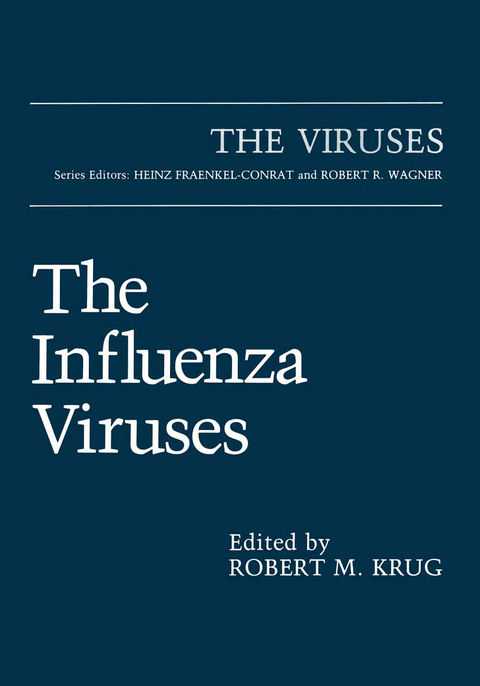
The Influenza Viruses
Springer-Verlag New York Inc.
978-1-4612-8094-1 (ISBN)
1 Genes and Proteins of the Influenza Viruses.- I. Introduction.- II. RNA Segments 1, 2, and 3: The Three Polymerase-Associated Proteins Form a Complex to Transcribe RNA.- III. RNA Segment 4: Synthesis, Structure, and Function of the Hemagglutinin.- IV. RNA Segment 5: The Nucleocapsid Protein Forms the Structural Monomer Unit of the Ribonucleoprotein Particles.- V. RNA Segment 6: The Neuraminidase.- VI. RNA Segment 7 of Influenza A Virus: Structure and Synthesis of the Membrane Protein (M1) and an Integral Membrane Protein (M2) from Unspliced and Spliced mRNAs.- VII. Influenza A Virus RNA Segment 8: Unspliced and Spliced mRNAs Encode Nonstructural Proteins NS1 and NS2.- References.- 2 Expression and Replication of the Influenza Virus Genome.- I. Introduction.- II. Viral mRNA Synthesis.- III. Template RNA Synthesis.- IV. Virion RNA Synthesis.- V. Regulation of Viral Gene Expression in Infected Cells.- VI. Interferon-Induced Mx Protein, a Specific Inhibitor of Influenza Virus Replication.- VII. Regulated Splicing of the Viral NS1 and M1 mRNAs.- VIII. Mechanisms for the Selective and Efficient Translation of Influenza Virus mRNAs.- References.- 3 Structure, Function, and Antigenicity of the Hemagglutinin of Influenza Virus.- I. Introduction.- II. Structure of Hemagglutinin.- III. Antigenic Variation.- IV. Receptor Binding.- V. Fusion Properties of Hemagglutinin.- VI. Conclusions.- References.- 4 Neuraminidase: Enzyme and Antigen.- I. Introduction.- II. Protein Structure.- III. Antigenic Structure.- IV. Summary.- References.- 5 Membrane Insertion and Intracellular Transport of Influenza Virus Glycoproteins.- I. Introduction.- II. Entry of Influenza Glycoproteins into the Exocytic Pathway.- III. Protein Transport between the Endoplasmic Reticulum and the Golgi Apparatus.- IV. Transport and Processing within the Golgi Apparatus.- V. The Trans-Reticular Network.- VI. Transport to the Cell Surface and Insertion into the Plasma Membrane.- VII. Summary and Perspectives.- References.- 6 Structure of Defective-Interfering RNAs of Influenza Viruses and Their Role in Interference.- I. Introduction.- II. Nature of the DI Particle Genome.- III. Generation of Influenza Virus Subgenomic/DI RNA.- IV. Evolution of DI RNAs.- V. Replication, Transcription, and Translation of DI RNAs.- VI. Mechanism of Interference.- VII. Possible Role of Influenza DI Particles in Modulating Viral Pathogenesis.- VIII. Possible Role of DI Particles in Virus Evolution.- IX. Summary and Conclusion.- References.- 7 Variation in Influenza Virus Genes: Epidemiological, Pathogenic, and Evolutionary Consequences.- I. Introduction.- II. Influenza Viruses in Humans.- III. Homology of Influenza A, B, and C Viruses.- IV. Variation in Influenza A Viruses.- V. Variation in Influenza C Viruses.- VI. Variation in Influenza B Viruses.- VII. Genetic Basis of Pathogenicity.- VIII. Comparison of Variation among Different RNA Viruses.- References.- 8 Specificity and Function of T Lymphocytes Induced by Influenza A Viruses.- I. Introduction.- II. General Properties of Antiviral T-Lymphocyte Responses.- III. Specificity and Function of Anti-influenza Virus TH.- IV. Specificity and Function of Anti-influenza Virus TC.- V. Conclusions.- References.
| Reihe/Serie | The Viruses |
|---|---|
| Zusatzinfo | 450 p. |
| Verlagsort | New York, NY |
| Sprache | englisch |
| Maße | 170 x 244 mm |
| Themenwelt | Sachbuch/Ratgeber ► Natur / Technik ► Garten |
| Medizin / Pharmazie ► Medizinische Fachgebiete ► Mikrobiologie / Infektologie / Reisemedizin | |
| Medizin / Pharmazie ► Studium | |
| Naturwissenschaften ► Biologie ► Botanik | |
| Naturwissenschaften ► Biologie ► Mikrobiologie / Immunologie | |
| Naturwissenschaften ► Biologie ► Ökologie / Naturschutz | |
| Naturwissenschaften ► Biologie ► Zoologie | |
| ISBN-10 | 1-4612-8094-X / 146128094X |
| ISBN-13 | 978-1-4612-8094-1 / 9781461280941 |
| Zustand | Neuware |
| Haben Sie eine Frage zum Produkt? |
aus dem Bereich


